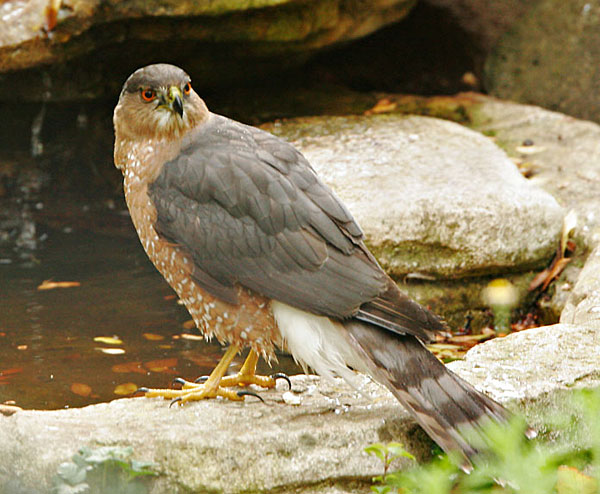The Cooper’s Hawk is a medium-sized hawk and they’re one of the most skillful fliers!
They have the classic hawk shape, with long tails and wide, rounded wings. Cooper’s Hawks heads appear to be large.
It can be hard to see Cooper’s Hawks because they prefer to stay in and around the woods. If you do manage to see one you’ll probably find it quickly moving through cluttered tree canopies in pursuit of other birds.
These birds can be hard to identify due to how similar they look to other birds.
Cooper’s Hawk Identification
Male and female Cooper’s Hawks look identical. They all have thick bands on their long tail, are steely blue-gray above, and have warm reddish bars on their underparts.
You can tell the difference between a male and a female by looking at their size, as with other birds of prey, females are larger than males.
Cooper’s Hawk size is great for identifying other birds too – these birds are larger than the similar Sharp-shinned Hawks and are about the size of a crow.
The adults exhibit a gray-blue back with a white underside, adorned with horizontal streaks of rufous bars.
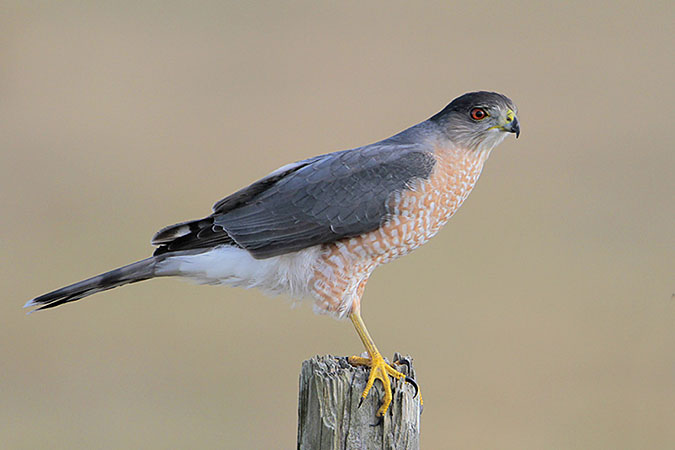
Females are larger in size, and because of this, they weigh more and have a larger wingspan. Juvenile Copper’s Hawks look different to the adults. They’re mostly brown above and have well-defined streaks on the upper breast.
Juvenile Cooper’s Hawks are easier to identify because they look less like a Sharp-shinned Hawk. Juvenile Cooper’s Hawks have a somewhat hooded look, while young Sharp-shinned Hawks’ have streaking that’s more diffused.
What Do Cooper’s Hawks Eat?
Cooper’s Hawks diet mainly consists of other birds and small mammals. They don’t usually go for smaller birds; they prefer medium-sized birds.
Some bird species with the Cooper’s Hawk as a predator are Mourning Doves, Rock Pigeons, European Starlings, American Robins, Northern Flickers, quail, chickens, and pheasants grouse, and several kinds of jays.
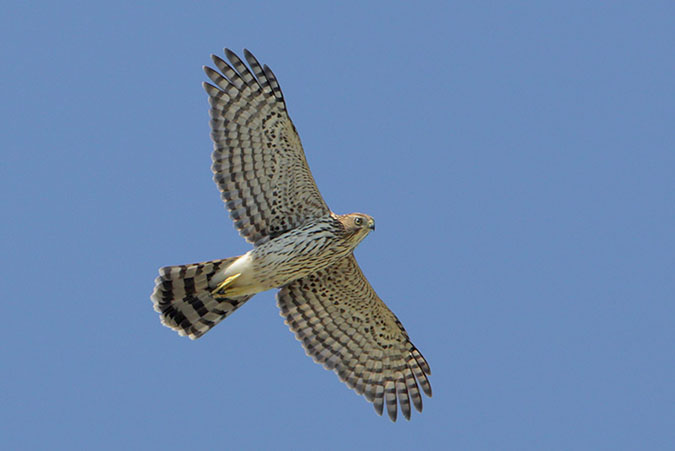
Cooper’s Hawks like to eat hares, chipmunks mice, bats, squirrels, and even rob other birds nests too. In the west, mammals are a larger part of the Cooper’s Hawks diet. They’ve been known to take advantage of backyard bird feeders. They will sit and wait on nearby trees and seize the opportunity to ambush a squirrel or bird on the ground.
If you notice a Cooper’s Hawk hanging around your feeders or have seen feathers on the ground, it’s recommended you take them down for a few days. This will prevent birds from coming, and the Cooper’s Hawk will move on.
Nesting and Eggs
Cooper’s Hawks will build their nests in dense woods in either oak trees, Douglas-firs, pine trees, beeches, or spruce trees. Their nests are usually placed in trees that are on flat ground instead of hillsides. Nests are usually 25 to 50 feet off of the ground and are on a horizontal branch or in a critch about two-thirds of the way up the tree.
Male Cooper’s Hawks are the ones to build the nest, with a little bit of help from the female. It takes them around two weeks. Nests are 6 to 17 inches high, 27 inches wide, and have a cup shape in the middle. The cup shape is usually around 8 inches wide and 4 inches deep. The outer part of the nest is made from sticks and the cup is lined with green twigs and bark chips.
There are 2-6 eggs, that the parents incubate for 30-36 days. After that, the young hawks stay in the nest for around 30 days.
Current Situation
Cooper’s Hawks are forest birds, but they have also been seen hanging out in the suburbs. Additionally, they can be found among trees along rivers in open country and are increasingly prevalent in suburbs and cities where tall tree provide suitable nest sites.
These tall and thin hawks are a common sight in quiet neighborhoods, parks, backyard feeders, and over fields. They’ve even been seen by busy streets if there are trees around.
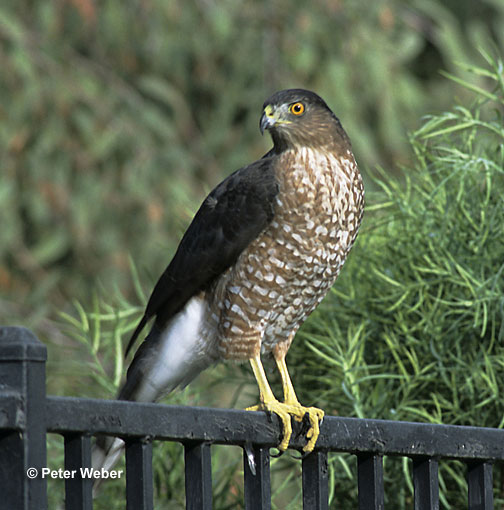
Cooper’s Hawk populations have been on the rise since the late 1960s. Their estimated breeding population is one million. According to the IUCN Red List, these hawks are a species of low concern.
The stable population rise is a turnaround from the mid-twentieth century. At that time, there was widespread use of a pesticide called DDT, which made its way into their food and poisoned them.
Additionally, the widespread shooting of these birds greatly reduced the population. Today, the primary cause of death for these birds is collisions with human-made objects.
Facts
- In a study of over 300 Cooper’s Hawk skeletons, 23 percent of those skeletons showed old fractures in the bones of the chest. Many of the fractures were on the wishbone and furcula. It’s theorized that these fractures are from dashing through vegetation at high speeds to catch other birds.
- A Cooper’s Hawk captures its prey (usually another bird) with its feet. It then kills its prey by repeatedly squeezing. Falcons tend to kill their prey by biting it, but Cooper’s Hawks hold their catch until it dies. Cooper’s Hawks can even drown their prey, while holding them from their feet. They’ll hold the bird underwater until it stops moving.
- It was once thought that these birds were against towns and cities. However, Cooper’s Hawks are now seen in urban and suburban birds. Some studies have even suggested that their numbers are actually higher in towns than in forests. Cities provide plenty of prey like Rock Pigeons and Mourning Doves. However, a study in Arizona found a downside to Cooper’s Hawks eating so much dove meat. Cooper’s Hawk nestlings were contracting a parasitic disease from eating dove meat.
- Like most hawk species, male Cooper’s Hawks are noticeably smaller than the females. The danger is that female Cooper’s Hawks specifically eat medium-sized birds. The males tend to be submissive to the females and will listen for reassuring calls the females make when they’re willing to be approached. Males are the ones to build the nest and provide nearly all the food to females and young.
- The oldest recorded Cooper’s Hawk was a male. He lived to be at least 20 years and 4 months old. He was originally captured and banded in California in 1986. The bird was later found in 2006 in the state of Washington.
- According to Cornell Lab of Ornithology, the oldest Cooper’s Hawk was 20+ years old.
- Famous namesakes are Cooper’s Hawk Winery and Restaurant
Similar Species
The Cooper’s Hawk has features that are similar to other bird species. Here are some similar species:
Sharp-shinned Hawk
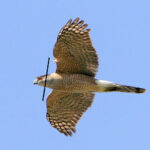 Cooper’s Hawks have larger and more square heads than Sharp-shinned Hawks.
Cooper’s Hawks have larger and more square heads than Sharp-shinned Hawks.
Cooper’s Hawks look like they have a cap on their head, thicker legs, and larger feet.
Juvenile Cooper’s Hawks have well-defined brown streaks on their chest while Sharp-shinned Hawks have broad, blurry streaks that go down onto the belly.
See more: Cooper’s Hawk vs Sharp-shinned Hawk
Lastly, Cooper’s Hawks have rounded tails while Sharp-shinned Hawks have square-tipped tails.
Northern Goshawk
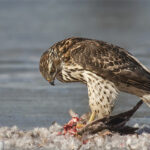
Northern Goshawk © Alan D. Wilson
Cooper’s Hawks are significantly smaller than Northern Goshawks. Adult Goshawks have shorter tails, are completely gray with a strong white eyebrow, and have longer wings than Cooper’s Hawks.
Juvenile Goshawks have a pale eyebrow, irregulely barred tail, and wide streaks on yellowish-brown underparts which helps identify it compared to a juvenile Cooper’s Hawks which has an evenly banded tail and whiter underparts.
Broad-winged Hawk
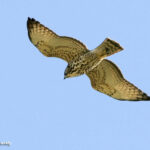 Broad-winged Hawks don’t have the “cap” that Cooper’s Hawks do.
Broad-winged Hawks don’t have the “cap” that Cooper’s Hawks do.
Additionally, they have shorter tails, and rounder, longer wings.
Peregrine Falcon
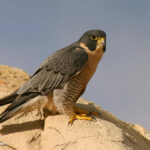
Cooper’s Hawks have rounder wings than adult Cooper’s.
Cooper’s Hawks have rusty barring while Peregrine Falcons have dark gray barring.
Lastly, Cooper’s Hawks have red eyes while Peregrine Falcons have brown eyes with yellow eyerings.
Frequently Asked Questions
Why is it called a Cooper’s Hawk?
Cooper’s Hawk was named after William Cooper by Charles Bonaparte in 1828. William Cooper was the person who collected the specimens that were used to describe the species.
Is it rare to see a Cooper’s Hawk?
Cooper’s Hawks are not rare, but they are stealthy. To see one, you need to keep your eyes peeled. It doesn’t help that they’re smaller than other hawks because it makes them harder to see.
What kills a Cooper Hawk?
Hawks are pretty high on the food chain, but larger birds like eagles are a treat to them. One of the biggest killers of these birds is pesticides. Pesticides infiltrate the food chain and reach predatory animals like hawks in high concentrations.
Are Cooper’s Hawks smart?
Yes, Cooper’s Hawks are very smart! They’ve been known to perch themselves in a nearby tree and wait. Instead of hunting down prey they’ll wait for a chance to ambush them.
Let others know your thoughts below or ask an expert

